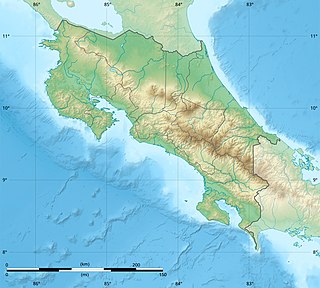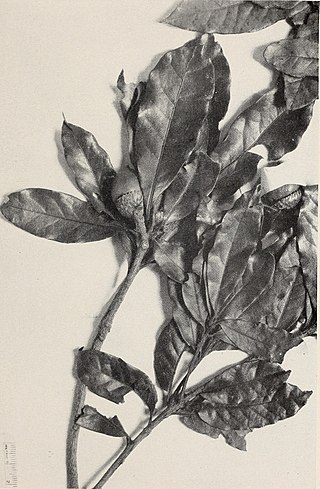
Costa Rica is located on the Central American Isthmus, surrounding the point 10° north of the equator and 84° west of the prime meridian. It has 212 km of Caribbean Sea coastline and 1,016 on the North Pacific Ocean.

Abarema is a neotropical genus in the family Fabaceae. It is native to Brazil, Cuba, and Venezuela. Most of the species can be found in the Amazon Basin and the Guyana Highlands. They have a deep-green fernlike foliage, with bipinnately compound leaves.

Cyrilla racemiflora, the sole species in the genus Cyrilla, is a flowering plant in the family Cyrillaceae, native to warm temperate to tropical regions of the Americas, from the southeastern United States, south through the Caribbean, Mexico and Central America to northern Brazil and Venezuela in South America. Common names include swamp cyrilla, swamp titi, palo colorado, red titi, black titi, white titi, leatherwood, ironwood, he huckleberry, and myrtle.

Abarema abbottii, the Abbott abarema, is a species of plant in the family Fabaceae. It is found only in the Dominican Republic, and is confined to broad-leaved woodlands on limestone soils.

Abarema centiflora is a species of plant in the family Fabaceae. It is endemic to the east slope of the Bolivian Andes. It is a small tree found in humid montane forests.

Abarema filamentosa is a species of plant in the family Fabaceae. It is endemic to the Brazilian states of Bahia and Espírito Santo, and is found in lowland wet Atlantic Forest and restinga.
Abarema obovata, the obovate abarema, is a species of plant in the family Fabaceae. It is endemic to the wooded hillsides of east and north-central Minas Gerais, Brazil.
Hydrochorea acreana is a tree species in the legume family (Fabaceae). It is native to portions of Central and South America, including Nicaragua, Costa Rica, Colombia, Venezuela, Peru, and northern Brazil. Fruiting trees apparently have never been found.

Pithecellobium is a genus of flowering plants in the family Fabaceae. It includes approximately 23 species from the tropical Americas, ranging from Mexico to Peru and northern Brazil, including the Caribbean Islands and Florida.
Aiouea obscura is a species of plant in the family Lauraceae endemic to Costa Rica. The species occurs on the southern Pacific slopes, south-east of Palmar north.
Freziera biserrata is a species of plant in the Pentaphylacaceae family. It is endemic to Costa Rica.
Guarea pyriformis is a species of plant in the family Meliaceae. It is endemic to Costa Rica.
Nectandra hypoleuca is a species of plant in the family Lauraceae. It is endemic to Costa Rica.
Damburneya longipetiolata is a species of plant in the family Lauraceae. It is endemic to Costa Rica.
Ocotea rivularis is a species of evergreen tree in the plant genus Ocotea of the family Lauraceae. It is endemic to Costa Rica.
Persea brenesii is a species of plant in the family Lauraceae. It is endemic to Costa Rica.
Quercus brenesii is a species of plant in the family Fagaceae. It is endemic to Costa Rica. It is placed in section Lobatae.

Quercus tonduzii is a species of oak. It is endemic to Costa Rica. It is placed in section Lobatae.

Abarema adenophora is a species of plant in the family Fabaceae. It is native to Northern South America, Costa Rica, and Nicaragua.
Abarema curvicarpa is a species of plant of the genus Abarema in the family Fabaceae. It can be found in Brazil, French Guiana, Guyana and Suriname.










